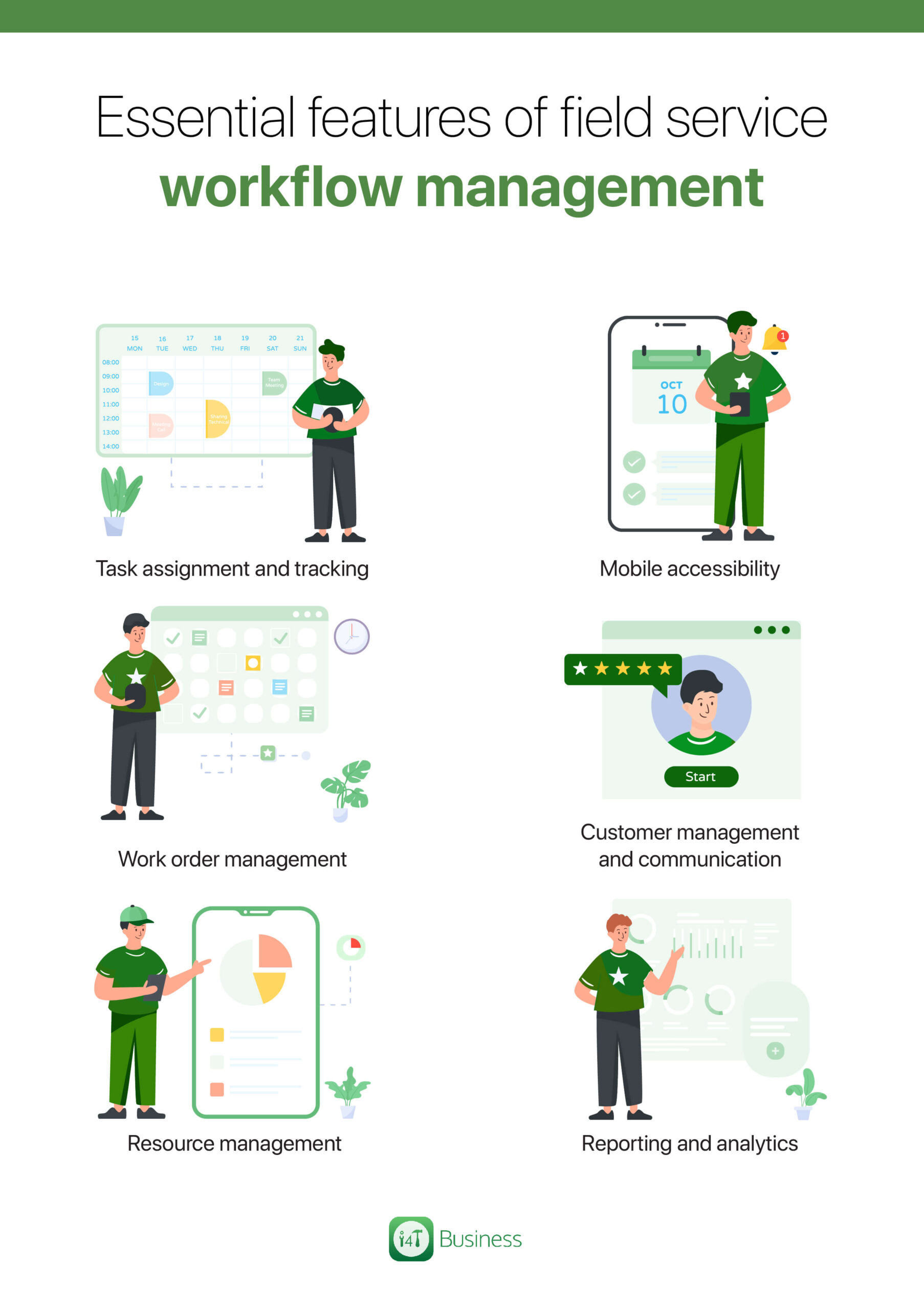Field service workflow management is an approach that is now being applied by many companies to deal with the problems of handling operations in the field.
The goal of field service workflow management is to make technicians more productive, make customers happy, and earn profits.
The need for speed and accuracy is pushing people away from the old ways of managing field services and toward automated and easy-to-use solutions. Field service workflow management has real benefits, like making processes run more smoothly, communicating better, and using resources better.
This article will focus on the most essential features that a field service workflow management system should have. Therefore, pay more attention to these features if you are planning to adopt a proper system for your business.
The importance of workflow management systems in field service management software
In field service management software, workflow management solutions are becoming increasingly important. It helps companies run smoothly and efficiently by coordinating all the different parts of the service delivery process.
Further, it helps to make a detailed plan for each step of service delivery. This mapping gives a clearer picture of the whole process, making it easier to plan, run, and keep track of. It also ensures that each job is given to the right person at the right time with the right tools.
Also, these systems make it easy to watch and get feedback in real-time, which is important for making changes and improvements at the right time. This real-time feature helps keep small problems from getting worse, saving time, money, and the company’s image.
How workflow management systems streamline operations and improve efficiency
Workflow management tools make operations easier and more efficient in many ways. First, they automate the repetitive chores of the employees. This lets them focus more on critical parts of their jobs. This technology makes service delivery faster, reduces mistakes, and boosts productivity.
Second, these methods make it easier for team members to talk to each other and work together. They make it easy for everyone to get and share information, cutting down on mistakes and miscommunications.
Lastly, workflow management tools give valuable information about how the business works. They make reports based on analytics that can be used to find bottlenecks, keep track of performance, and make choices based on good information.
Essential features of field service workflow management

1. Task assignment and tracking
One of the crucial features of field service workflow management is task assignment and tracking. This feature helps you to ensure that tasks are assigned to the most suitable person based on their skills, availability, and location. It helps you prioritize tasks according to urgency and allocate staff accordingly. This will minimize delays and bottleneck situations.
It also enables real-time task progress tracking, facilitating timely adjustments and corrections. This ensures that the jobs are completed within the allocated time. As you can see, these features are critical to improve customer satisfaction and optimize resource allocation.
2. Scheduling and dispatching
Scheduling and dispatching help to plan and schedule tasks depending on various factors. These factors can be task urgency, employee availability, and geographical location.
This helps to allocate jobs to technicians based on their availability, skills, and distance from the customer’s location, among other things. With this feature, you can quickly put the right technician on the right job.
Field service workflow management systems improve operational efficiency by automating scheduling and dispatching processes.
3. Mobile accessibility
In today’s digital age, mobile accessibility is a must-have feature. It allows field workers to access the system from anywhere using their mobile devices. Therefore technicians can get real-time updates, see what jobs they have been given, get customer information, and talk to their supervisors.
This feature helps technicians to stay connected and up-to-date from anywhere they want. Therefore, they can do their jobs quickly without returning to the office for updates or paperwork. Mobile access also makes it easy to take notes, take photos, sign documents, and share them directly from the field.
A field service workflow management system that can be used on a mobile device increases productivity, reduces paperwork, and helps people collaborate better. This leads to improved customer service and satisfaction.
4. Work order management
Work order management is a feature that oversees the entire lifecycle of a work order, from creation to closure.
It ensures that work orders are documented correctly and given to the right employee based on their skills and availability. It also lets you track the progress of work orders in real-time. This ensures that the task completion process is clear and transparent.
This feature also makes it easy to update or change the work orders to meet changing customer needs or situations.
Work order management speeds up the whole process, improves teamwork, and makes field service operations more efficient and effective.
5. Customer management and communication
This is a feature that manages all customer-related activities and enables seamless communication with customers. It facilitates timely updates and responses.
This helps businesses to easily handle information about their customers, such as their contact information, service history, preferences, and special needs. Therefore you can give a better and more personalized service to the customer.
Further, this feature makes it easier for technicians and customers to talk to each other by facilitating real-time updates, appointment reminders, and progress alerts. This ensures that customers know how their service requests are coming along thereby reducing confusion and improving the overall customer experience.
Customer management and communication features also make it easy to get customer feedback. This lets businesses gain useful information and keep improving their services based on what customers say. Field service workflow management systems build stronger connections with customers and make them more loyal by putting customer satisfaction and communication first.
6. Resource management
Resource management is a feature that ensures optimal use of resources. It aids in tracking and managing inventory, equipment, and other resources, reducing wastage and unnecessary costs.
Field service workflow management systems help you track technicians’ availability, skills, and workloads. Therefore you can send the right worker to the right job. Further, route optimization helps technicians get from one job to the next quickly and efficiently. This helps businesses be more productive and save money on fuel.
Further, these features help keep track of and manage inventory. Thereby ensuring that technicians have all the necessary parts, tools, and equipment to do their jobs. Field service workflow management improves operational efficiency by making assigning and using resources easier. This cuts back on downtime and increases customer satisfaction by ensuring services are delivered on time and up to the mark.
7. Reporting and analytics
Field service workflow management systems have useful tools like reporting and analytics that help companies make decisions based on data. Comprehensive reports help measure technicians’ productivity, response times, customer satisfaction, and how well resources are being used. This helps find places to improve things and keeps track of performance trends.
Analytics help businesses find patterns and trends in field service data and deal with problems by taking preventive steps before they happen. Reporting and analytics give companies the tools to measure performance, drive continuous improvement, and make their field service operations more efficient.
8. Integration with other systems
Integration capabilities are a vital part of any field service workflow management system. It makes it more efficient and helps people connect. Integrating smoothly with systems like project management, and billing ensures that information flows smoothly and that data is in sync.
This connection makes it possible to share data in real time without entering it by hand, which cuts down on mistakes. It helps businesses to get a centralized workflow that makes it easier for departments to work together and coordinate.
This improves productivity, and customer satisfaction, and ensures better use of resources.
Integration is a key part of any field service workflow management system because it lets different solutions talk to each other, and process information from one centralized platform.
Conclusion
In conclusion, field service workflow management is an invaluable tool for any business aiming to streamline operations and maximize efficiency. Incorporating the above features into the system will improve service delivery and enhance business performance. Therefore, it’s not just an option but a necessity for businesses in today’s competitive field service landscape.
You should be able to implement a better field service workflow management system with field service management software. i4T Business is a comprehensive software that has helped many businesses to implement a better workflow management system. It has all the above features and we make it a responsibility to keep the technology up-to-date with the industry requirements.
Explore the potential of field service workflow management for your business and see the difference it can make in your operations and profitability. Learn more about i4T Business Field Service Management Software or Contact us for a free trial today.
FAQs
This is a system that helps businesses manage and coordinate their field service processes. It improves customer satisfaction, boosts profits, and makes the business more productive.
Yes, it can work with other systems like CRM, inventory management, and billing tools. This integration ensures that information flows smoothly, eliminates the need to manually enter data, and improves connection.
Integration with other systems allows data to be shared in real-time, changes to be made automatically, and workflow to be centralized. It streamlines processes, makes it easier for teams to work together, and makes field service operations more efficient overall.
Using field service workflow management has benefits, such as streamlining processes, improving communication, and using resources better. Further, it helps to increase productivity, make customers happier, and, in the end, allows businesses to make more money.
Customer management and communication help businesses keep in touch with their customers well. It ensures that updates are done on time, delays are minimized, and customers are satisfied, by delivering services smoothly.
Hot off the press!

With our cutting-edge technology and in-depth knowledge of how the Field Service Management sector operates, the i4TGlobal Team loves to share industry insights to help streamline your business processes and generate new leads. We are driven by innovation and are passionate about delivering solutions that are transparent, compliant, efficient and safe for all stakeholders and across all touch points.




